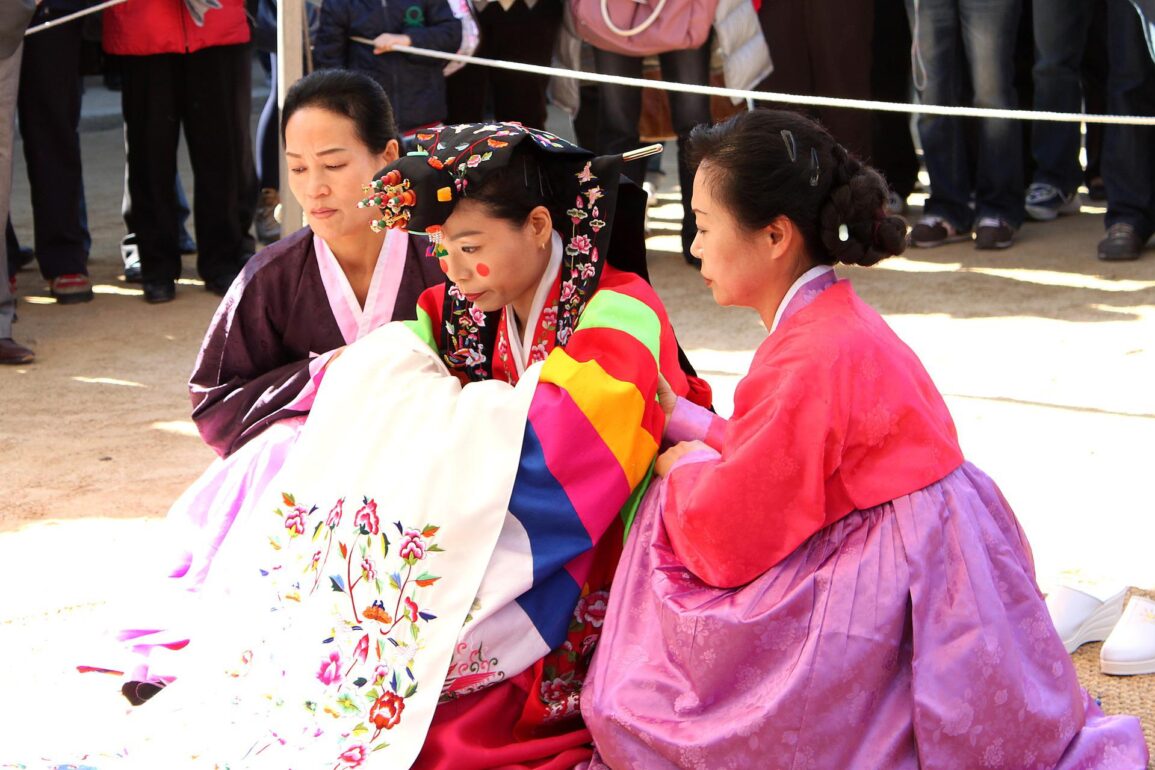Just like any other country in the world, Korea doesn’t make an exception that in the past it was common to see Korean arranged marriages. Nowadays, the long holiday periods – such as Lunar New Year and Chuseok – are generally a time of festivity and happiness but for young unmarried Koreans, it is a time of stress brought on by the constant inquiries of family members as to when they will marry. But this is not a new phenomenon. During the Joseon era, it was considered abhorrent for a person to never marry. Males – no matter what their age – were considered children until they married. Occasionally boys were married as preteens but the general age for marriage was sixteen or seventeen. Isabella Bird Bishop, an Englishwoman who traveled in Korea during the 1890s, noted that “a man gains the reputation of being a neglectful father who allows his son to reach the age of twenty unmarrieds.” Girls, sometimes merely children, were married whenever their parents saw a favorable opportunity. These young brides were not “obliged to assume the duties of wifehood till [they were] sixteen.”
How Korean Arranged Marriages were settled?
Marriage brokers were generally employed to arrange these weddings. These marriage brokers would examine the potential family’s background, finances, and the physical appearance of the young man or woman. Marriages were rarely based upon love but were instead means of increasing wealth or political standing amongst the families. But these marriage brokers were not always the most honest people as evidenced by this anecdote from the late 1890s.

A wedding was arranged between a young girl from a well-to-do family and a handsome young man. Some of the girl’s family went to the potential groom’s house to ascertain the claims of the marriage broker and were quite impressed by the obviously affluent, well-dressed man and the beautiful house he lived in. After an elaborate wedding, the groom took his new wife to his true home – a wretched house where his father, mother, and a large family lived huddled together like rabbits in a hole. It was a horrible shock for the young girl who was accustomed to living in luxury. Many victims accepted such deceptions in silence, mortified with fear that others might learn of their true fate.
What were the customs before the marriage?
There was usually a period of betrothal when the elder members of the family visited one another to ascertain the suitability of the young couple. The silk for the young bride’s dress was provided by the groom’s father. The silk was carried to the bride’s home at night by a group of the groom’s friends. They were often set upon by a group of men sent from the bride’s home and a mock battle ensued. Occasionally there were deaths. If the groom’s side lost, it was viewed as a portent of bad luck and the marriage was doomed. It goes without saying that there were a lot of superstitions associated with weddings and some parents sought out supernatural advice from fortune-tellers before allowing their children to marry.

One great fear for young brides was the thought of being widowed early. Unable to remarry, widows faced a lifetime of loneliness and chastity. If a fortune-teller foretold the early death of the groom, the bride’s family sometimes went to extreme measures to protect not only their daughter but also the groom. One such act was a sham marriage. On the day before the real wedding, a young boy would be lured to the bride-to-be’s home and forced to partake in a mock wedding with her. After the ceremony, he was strangled, and then later that night, his body was smuggled out and buried or left in the open for wild dogs and animals to feed on. It was thought that through this sham wedding, the prophecy of the bride becoming a young widow would be fulfilled and her real marriage the following day would be blessed.
The reality of brokers and the evolution of Korean arranged marriages
While many of these superstitions of the past disappeared with the dawn of the twentieth century, arranged marriages lingered on. In the 1930s one observer reported, “It sometimes happens that quite small girls of poor families are bought by a broker and afterward sold as wives to men in other parts of Korea long before they have reached marriageable age. The price runs to about sixty or seventy yen and a bill is made out just as in the case of any other merchandise. The Korean outdoor servant of one of my acquaintances in Keijo [Seoul] bought a young wife in this way for his son through a woman broker for seventy yen. A girl who is bought in this way belongs to the purchaser absolutely and may be sold again by him.” Marriage brokers were quite popular until the 1980s when more and more people left their ancestral villages for the large cities. It is also thought that the 1988 Olympics and the subsequent relaxation of the ban on foreign travel helped change the mindset of the younger generations. While arranged marriages are no longer as popular as they were in the past, they are still a part of Korean culture. As late as 2007, a number of parents of unwed children in the affluent areas of Gangnam and Bundang reported that they favored using matchmakers because they feared that their children might remain single and they wanted to ensure that their children’s spouses be from the same economic and cultural backgrounds.
Check out our article on what your Korean wedding should look like!
And if you want more information on forced marriage, check out this article in the Korea Times!


